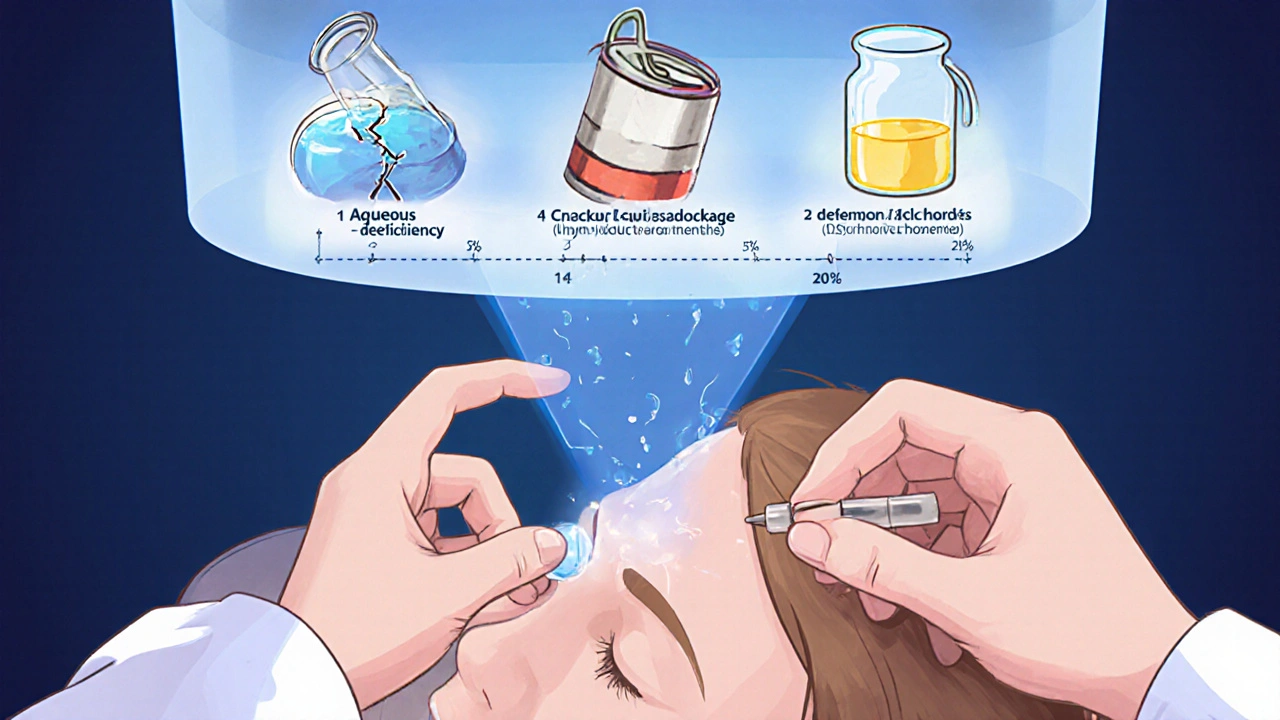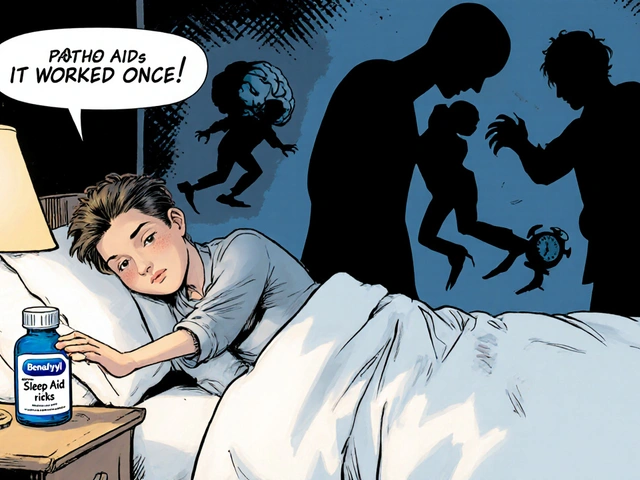When your eyes feel gritty, burn after staring at a screen, or water uncontrollably even though they feel dry-you’re not imagining it. This is dry eye syndrome, one of the most common eye complaints affecting millions, yet often dismissed as just "a little irritation." The truth is, dry eye isn’t just discomfort-it’s a breakdown in the tear film that protects your vision. Without proper treatment, it can lead to lasting damage.
What Exactly Is Dry Eye Syndrome?
Dry eye syndrome, also called dysfunctional tear syndrome or dry eye disease, isn’t simply about not having enough tears. It’s about the tear film not working the way it should. Your eyes are coated in a thin, three-layered film that keeps them moist, smooth, and protected. When any part of this film fails, your eyes start to break down.The tear film has three layers:
- Lipid layer (oil): The outermost layer, made by glands in your eyelids. It stops tears from evaporating too fast.
- Aqueous layer (water): The middle layer, produced by tear glands. This is what hydrates your eye.
- Mucin layer (mucus): The inner layer, which helps tears stick to the eye surface.
Normal tear film lasts 15 to 35 seconds before it breaks up. In dry eye, it breaks in under 10 seconds. That’s like trying to keep a puddle from drying up on a hot day with no cover. When this happens, your eye surface gets irritated, inflamed, and can even scar.
The Two Main Types: Aqueous Deficiency vs. Evaporative Dry Eye
Not all dry eye is the same. There are two main types, and they need different treatments.Aqueous tear-deficient dry eye (ADDE) happens when your tear glands don’t make enough water. This affects about 10-15% of people with dry eye. It’s often linked to aging, autoimmune diseases like Sjögren’s syndrome (which affects mostly women), or medications like antihistamines and antidepressants. If your tear osmolarity (salt concentration) rises above 308 mOsm/L, that’s a clear sign your tears are too concentrated and damaging your eye.
Evaporative dry eye (EDE) is far more common-making up 85-90% of cases. Here, your tear glands make enough water, but the oil layer is missing or too thin. This lets tears evaporate too quickly. The culprit? Blocked or inflamed meibomian glands in your eyelids. This is often caused by blepharitis, long screen use, or contact lens wear. People with EDE often have watery eyes because their body tries to overcompensate for the dryness-but those tears lack oil and evaporate just as fast.
That’s why some people with dry eye feel like their eyes are constantly watering. It’s not an overproduction-it’s a broken system.
How Artificial Tears Work (and Where They Fall Short)
Artificial tears are the first line of defense for most people with dry eye. They’re designed to replace what’s missing in your natural tear film. But not all drops are created equal.Good artificial tears contain:
- Electrolytes: Sodium and potassium to match your natural tear chemistry (130-150 mM sodium).
- Viscosity agents: Like carboxymethylcellulose or hyaluronic acid. These help the drops stick around longer. A 0.15% sodium hyaluronate solution can last over 4 hours; basic saline might only last 2.5 hours.
- Preservatives or none: Preservatives like benzalkonium chloride (BAK) help multi-dose bottles stay sterile-but they can damage your eye surface if you use them more than 4 times a day. For frequent users, preservative-free single-dose vials are better.
For aqueous deficiency, artificial tears work well-they directly replace the missing water. But for evaporative dry eye, plain water drops don’t fix the real problem: the missing oil layer. That’s why some people feel relief for minutes, then the burning comes back.
Studies show preservative-free drops give 37.2% better symptom relief in severe cases. One user on Reddit switched from a standard brand to Retaine HPMC and went from barely wearing contacts to 8 hours a day. Another user found Systane Hydration helped mild dryness but said it wore off in 1-2 hours. That’s the reality: artificial tears are a bandage, not a cure.
How to Use Artificial Tears Right
Using them wrong makes them less effective-and can even make things worse.Here’s how to apply them properly:
- Tilt your head back slightly.
- With one hand, gently pull down your lower eyelid to create a small pocket.
- Hold the bottle 1-2 cm away from your eye-don’t let the tip touch your skin or lashes.
- Squeeze out one drop. One. Not two. Not three.
- Close your eye gently for 30 seconds. Blink slowly a few times to spread the drop.
- If you’re using another eye drop, wait at least 5 minutes between them.
Most people apply too many drops at first-on average, 2.3 instead of 1. That’s wasteful and can blur your vision. It takes most people 7-14 days to get the technique right.
Also, store your drops properly. Most can stay at room temperature, but preservative-free single-dose vials must be refrigerated. Some users swear by keeping their drops in the fridge-it thickens the solution slightly and gives a 22% longer-lasting effect.
When Artificial Tears Aren’t Enough
If you’re using artificial tears 4 or more times a day for over 4-6 weeks and still feel gritty, burning, or have blurred vision that comes and goes-you need more than drops.Signs you need professional help:
- Corneal staining (seen with fluorescein dye) at grade 3 or 4 on the Oxford scale
- Fluctuating vision (blurring that changes throughout the day)
- Pain that feels like needles or sand in your eyes
- Redness that doesn’t improve
At this stage, doctors may prescribe:
- Cyclosporine (Restasis) or lifitegrast (Xiidra): These reduce inflammation and help your eyes make more tears over time. They take weeks to work, but studies show they improve symptoms by 68%-much better than artificial tears alone.
- Punctal plugs: Tiny devices inserted into tear ducts to keep natural tears on your eye longer. About 23% of people experience them falling out on their own.
- Eysuvis (ketotifen): A new FDA-approved eye drop for short-term flare-ups. It works in as little as 15 minutes.
- TrueTear: A small device that stimulates nerves to trigger your own tear production. Used for 1-2 minutes, it boosts natural tears by 31.2% in aqueous-deficient cases.
And don’t forget nighttime solutions. Ointments (like petrolatum-based ones) can be thick and blurry, but they last 6-8 hours. Use them before bed, not during the day.

The Bigger Picture: Why Dry Eye Is Getting Worse
Dry eye isn’t going away-it’s growing. By 2030, the global market for dry eye treatments is expected to hit $8 billion. Why?- Aging population: Over half of people over 50 have dry eye. By 2034, 22% of the U.S. will be 65 or older.
- Digital screens: We stare at screens 7.4 hours a day on average. Blinking drops by 66% during screen use, which dries out the tear film faster.
- Environmental factors: Air conditioning, heating, wind, and low humidity all speed up tear evaporation.
- Medications: Antihistamines, antidepressants, birth control, and blood pressure drugs all increase risk.
Even contact lens wearers are at higher risk. One user reported that standard artificial tears made their lenses feel gritty-until they switched to a formula designed for lens wearers.
What’s Next for Dry Eye Treatment?
The future is personal. By 2025, 73% of eye specialists will use tear osmolarity testing in their clinics to diagnose dry eye accurately-not just guess based on symptoms.Researchers are testing new treatments:
- Lacritin protein therapy: A natural tear protein that helps rebuild tear film. Early results show promise.
- Sustained-release hydrogel inserts: Tiny, dissolvable inserts placed in the eye that release lubricant over 12 hours.
- Microbiome treatments: Targeting bacteria on the eyelid that trigger inflammation.
The goal isn’t just to add drops-it’s to restore your eye’s natural ability to protect itself.
Final Thoughts: Don’t Just Suffer in Silence
Dry eye syndrome isn’t a minor annoyance. It’s a chronic condition that affects your daily life-reading, driving, working, even sleeping. Artificial tears help many people, but they’re not the whole answer. If you’re using them daily and still struggling, it’s time to see an eye specialist. There are better options now than ever before.Start by tracking your symptoms: How often do you use drops? When does your vision blur? Do your eyes water more than they burn? That info helps your doctor decide if you have aqueous deficiency, evaporative dry eye, or something else entirely.
Your eyes are worth more than a quick fix. Treat them like the delicate, vital organs they are.
Can artificial tears cure dry eye syndrome?
No, artificial tears don’t cure dry eye syndrome. They only relieve symptoms by replacing missing moisture. They don’t fix the root cause-whether it’s poor tear production, blocked oil glands, or inflammation. For long-term relief, especially in moderate to severe cases, treatments like cyclosporine, lifitegrast, or punctal plugs are needed.
Are preservative-free artificial tears better?
Yes, if you use artificial tears more than 4 times a day. Preservatives like benzalkonium chloride can damage the surface of your eye over time, especially with frequent use. Preservative-free single-dose vials eliminate this risk and are recommended for daily users. They’re more expensive, but safer for long-term use.
Why do my eyes water if I have dry eye?
It sounds counterintuitive, but it’s common. When your tear film is unstable or evaporates too quickly, your eyes send a distress signal. Your body responds by producing reflex tears-but these are mostly water and lack the oil and mucus needed to stay on the eye. So you get watery eyes that don’t actually help the dryness.
Can screen time cause dry eye?
Yes. When you focus on screens, you blink up to 66% less than normal. Less blinking means the tear film isn’t spread evenly across your eye, leading to faster evaporation. This is why digital eye strain is now one of the top causes of dry eye, especially in people under 40.
How do I know if I have aqueous deficiency or evaporative dry eye?
Only an eye doctor can tell for sure. They’ll use tests like the Schirmer test (measures tear production), tear breakup time (how fast your tears evaporate), and meibomian gland evaluation (checking oil gland function). If your tear osmolarity is above 308 mOsm/L, that’s another strong indicator of dry eye disease.
Should I use eye drops before or after my contacts?
Always remove your contacts before using eye drops unless the product is labeled "safe for contact lens wear." Some drops contain ingredients that can stick to lenses and cause irritation. After applying drops, wait 10-15 minutes before reinserting your lenses. Look for drops specifically designed for contact lens wearers-like Retaine HPMC or Systane Ultra.



Jessica Correa on 24 November 2025, AT 08:55 AM
Been using preservative-free drops for 6 months now and my contacts finally feel comfortable again. No more burning after 2 hours. Seriously, if you're on them daily, skip the stuff with BAK. It's not worth the irritation.